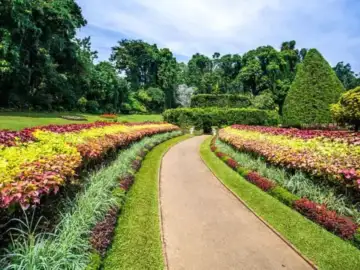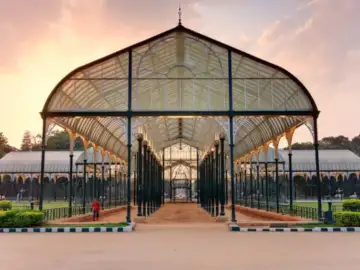Cities are often described in terms of skylines, traffic, and neon lights. But beneath the concrete and chaos, there are lungs that quietly keep them alive.
Botanical gardens.
They are not just tourist stops with trimmed lawns and rare trees. They are living museums of evolution, sanctuaries of silence, and classrooms without walls. Step inside one, and the noise of the city fades. Time slows. Even the air feels different – cleaner, wiser, older.
Most travelers rush to landmarks, palaces, or shopping hubs. But what if we told you that the soul of Asia lies not in its crowded streets, but in its green sanctuaries? These botanical gardens are more than pretty backdrops. They are storytellers of history, biodiversity, and cultures.
Let’s wander through the five most beautiful botanical gardens in Asia, where nature unfolds its secrets, one leaf at a time.
1. Singapore Botanic Gardens : Where Orchids Write Poems
In a city obsessed with speed, the Singapore Botanic Gardens is a pause button. Over 160 years old and a UNESCO World Heritage Site, it is the oldest garden of its kind in Asia. But what makes it remarkable isn’t just its age – it’s its artistry.
Imagine walking through the National Orchid Garden, where over 1,000 species and 2,000 hybrids bloom like a living rainbow. Each orchid feels like a delicate brushstroke, painting stories of resilience and beauty. Here, nature doesn’t imitate art. It becomes art.
What to Experience:
- Stroll around the Swan Lake, where white swans glide effortlessly across water framed by ancient trees.
- Explore the Rainforest Trail, a preserved patch of original jungle that predates the city itself.
- Visit early morning, when joggers share paths with photographers chasing golden light.
This isn’t just a garden. It’s proof that a hyper-modern city can still hold onto its roots – literally.
2. Royal Botanic Gardens, Peradeniya (Sri Lanka) : The Garden of Kings

Near Kandy, Sri Lanka’s cultural heart, lies the Royal Botanic Gardens of Peradeniya. Once reserved for Kandyan kings, today it welcomes everyone who seeks shade under its 4,000 species of plants.
The most breathtaking sight? The Avenue of Royal Palms – a long boulevard where perfectly aligned palms rise like natural pillars, creating a cathedral of green. Beneath them, couples walk slowly, families picnic, and students sketch.
Other highlights include the Great Lawn, dominated by a massive Java fig tree whose canopy spreads like a green umbrella, and the Medicinal Garden, where ancient healing traditions meet modern botany.
What to Experience:
- Take a quiet walk along the palm-fringed avenues.
- Explore the Spice Garden to trace Sri Lanka’s historic role in the global spice trade.
- Watch colonies of giant fruit bats hanging like strange ornaments from tall trees.
Peradeniya is not just a garden; it’s a reminder that power fades, but nature outlasts empires.
3. Shinjuku Gyoen National Garden (Japan) : Where Seasons Change Like Haiku
Tokyo is famous for neon signs and bullet trains, but at the heart of this restless city is the Shinjuku Gyoen National Garden, a world where stillness reigns. Spread across 144 acres, it blends three landscapes – French formal, English landscape, and traditional Japanese gardens.
In spring, cherry blossoms paint the garden in pink clouds. In autumn, fiery red maples ignite the pathways. And in winter, silence deepens with frost-kissed ponds. Every season here feels like a haiku – fleeting, precise, beautiful.
What to Experience:
- Sit beside the traditional Japanese Tea House and sip matcha while gazing at koi ponds.
- Walk across the wooden bridges that curve gently over serene waters.
- Visit during early morning hours, when mist rises from the lawns and Tokyo’s skyscrapers fade into the background.
Shinjuku Gyoen is not just a garden. It’s Tokyo’s beating heart of calm, a reminder that harmony can exist even in the world’s busiest city.
4. Lalbagh Botanical Garden, Bengaluru (India) : The Garden of Red Earth and Glass

Bengaluru may be called India’s Silicon Valley, but long before tech parks came glasshouses. The Lalbagh Botanical Garden, commissioned by Hyder Ali and later expanded by Tipu Sultan, is over 240 acres of horticultural history.
Its jewel is the Glass House, modeled after London’s Crystal Palace, where flower shows bloom into festivals of color. But Lalbagh is more than events. It’s about trees that have watched centuries pass. The 200-year-old Lalbagh Rock, one of the world’s oldest geological formations (3,000 million years old), tells stories older than civilization.
What to Experience:
- Walk under the shade of rare tropical and subtropical plants.
- Visit the Lalbagh Lake, where pelicans and herons rest.
- Sit quietly under the canopy of the Silk Cotton tree, and you’ll understand why poets once found muse here.
Lalbagh isn’t just Bengaluru’s garden. It’s its memory – rooted, resilient, and red with earth.
5. Nong Nooch Tropical Botanical Garden, Thailand : Where Fantasy Meets Flora
If gardens are usually about peace, Nong Nooch Garden in Pattaya is about spectacle. Spread over 500 acres, it’s a blend of cultural shows, themed landscapes, and one of the most diverse collections of tropical plants in Asia.
Here, every corner feels curated, from French gardens with symmetrical hedges to Stonehenge replicas wrapped in green. Orchid nurseries burst with color, while cactus gardens remind you that deserts, too, are beautiful.
What to Experience:
- Wander through the European-inspired gardens, where symmetry meets tropical abundance.
- Explore the Cycad Collection, one of the largest in the world.
- Catch a cultural performance, where Thai traditions come alive against a backdrop of blooming flowers.
Nong Nooch is not subtle. It’s flamboyant, theatrical, and unforgettable – a celebration of how creativity can shape nature without stealing its essence.
Why Botanical Gardens Matter More Than Ever
Isn’t a garden just a park with flowers? Not quite.
Botanical gardens are living libraries. They preserve endangered species, teach children about biodiversity, and remind city-dwellers that nature isn’t an escape – it’s home. They provide oxygen, beauty, and perspective in a world that forgets to pause.
Here’s what they give us that malls or monuments can’t:
- Sanctuary: A place to rest not just your feet, but your mind.
- Heritage: Every tree here has a history – planted by kings, nurtured by botanists, or saved from extinction.
- Community: Locals walk, jog, meditate, and picnic here. Tourists photograph. Researchers study. Nature unites them all.
Practical Tips: How to Garden-Walk Like a Local
- Go early. Mornings gift you solitude, soft light, and cooler air.
- Wear comfortable shoes. These gardens are vast, and the best discoveries happen on foot.
- Pause often. Don’t just walk. Sit on a bench. Watch a leaf fall. Listen to a bird call.
- Respect the space. Gardens aren’t amusement parks. They’re sacred in their silence.
Final Thought
The most beautiful part of a botanical garden isn’t the orchids, the lawns, or the lakes. It’s the way they make you feel – smaller, quieter, more connected.
So the next time you plan a trip to Asia, don’t just chase skyscrapers or beaches. Step into these gardens. Let the trees tell you their stories, let the flowers write you into their poems.
Because cities may build towers, but it’s the gardens that keep them alive.
